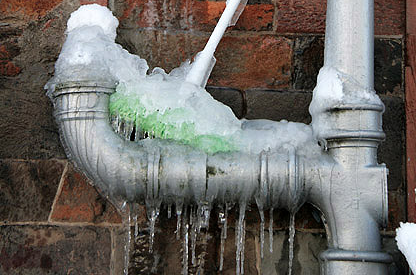Avoiding Frozen Plumbing in Cold Weather: Essential Advice
Avoiding Frozen Plumbing in Cold Weather: Essential Advice
Blog Article
We've found the article involving Prevent Frozen Pipes listed below on the internet and accepted it made sense to share it with you on this page.

Cold weather can damage your pipes, specifically by freezing pipelines. Below's how to stop it from taking place and what to do if it does.
Intro
As temperatures drop, the risk of frozen pipes increases, potentially leading to costly repairs and water damage. Understanding how to prevent icy pipelines is critical for property owners in chilly climates.
Avoidance Tips
Insulating prone pipelines
Wrap pipelines in insulation sleeves or make use of heat tape to secure them from freezing temperature levels. Focus on pipes in unheated or external areas of the home.
Heating methods
Maintain indoor spaces adequately warmed, specifically locations with pipes. Open up closet doors to allow warm air to distribute around pipes under sinks.
Just how to recognize icy pipelines
Look for decreased water flow from faucets, unusual smells or sounds from pipelines, and noticeable frost on subjected pipes.
Long-Term Solutions
Architectural modifications
Think about rerouting pipelines far from outside wall surfaces or unheated locations. Include extra insulation to attic rooms, cellars, and crawl spaces.
Upgrading insulation
Invest in top notch insulation for pipes, attics, and wall surfaces. Proper insulation helps maintain constant temperature levels and reduces the threat of frozen pipelines.
Shielding Exterior Plumbing
Yard hose pipes and exterior faucets
Separate and drain pipes yard hoses prior to winter. Set up frost-proof faucets or cover outside taps with insulated caps.
Comprehending Icy Pipelines
What triggers pipelines to ice up?
Pipes freeze when subjected to temperature levels listed below 32 ° F (0 ° C) for extended periods. As water inside the pipes ices up, it expands, putting pressure on the pipe wall surfaces and possibly triggering them to burst.
Dangers and problems
Frozen pipes can result in water supply interruptions, home damages, and costly fixings. Ruptured pipelines can flooding homes and create considerable architectural damages.
Indicators of Frozen Pipes
Identifying icy pipes early can prevent them from rupturing.
What to Do If Your Pipes Freeze
Immediate activities to take
If you suspect icy pipes, maintain faucets open up to ease pressure as the ice melts. Make use of a hairdryer or towels taken in warm water to thaw pipes gradually.
Verdict
Stopping frozen pipes calls for positive measures and fast feedbacks. By comprehending the reasons, indicators, and safety nets, home owners can safeguard their plumbing throughout cold weather.
6 Proven Ways to Prevent Frozen Pipes and Protect Your Home
Disconnect and Drain Garden Hoses
Before winter arrives, start by disconnecting your garden hoses and draining any remaining water. Close the shut-off valves that supply outdoor hose bibs and leave the outdoor faucet open to allow any residual water to drain. For extra protection, consider using faucet covers throughout the colder months. It’s also important to drain water from any sprinkler supply lines following the manufacturer’s directions.
Insulate Exposed Pipes
Insulating your pipes is an effective way to prevent freezing. Pipe insulation is readily available at home improvement stores and is relatively inexpensive. Pay close attention to pipes in unheated areas such as the attic, basement, crawl spaces, or garage. Apply foam insulation generously to create a buffer against the cold. You can also wrap your pipes in heat tape or thermostat-controlled heat cables for added warmth.
Seal Air Leaks
Inspect your home for any cracks or openings that could let in cold air. Seal any holes around the piping in interior or exterior walls, as well as the sill plates where your home rests on its foundation. Additionally, make sure to keep your garage door closed unless you’re entering or exiting. Leaving it open creates a significant air leak that can lead to frozen pipes.
Allow Warm Air Circulation
During cold snaps, it’s essential to allow warm air to circulate evenly throughout your home. Leave interior doors ajar to promote better airflow. Open kitchen and bathroom cabinets to help distribute heat consistently around the rooms. If you have small children or pets, be sure to remove any household chemicals or potentially harmful cleaners from open cabinets for safety.
Let Faucets Drip
A small trickle of water can make a big difference in preventing ice formation inside your pipes. When temperatures drop significantly, start a drip of water from all faucets served by exposed pipes. This continuous flow helps prevent the water from freezing. Additionally, running a few faucets slightly can relieve pressure inside the pipes, reducing the chances of a rupture if the water inside does freeze.
https://choateshvac.com/6-proven-ways-to-prevent-frozen-pipes-and-protect-your-home/

I'm very occupied with Winter Plumbing Precautions: Preventing Frozen Pipes and I'm hoping you enjoyed the new blog entry. If you please set aside a second to promote this article if you enjoyed reading it. Thanks for being here. Come back soon.
Schedule Free Estimate Report this page